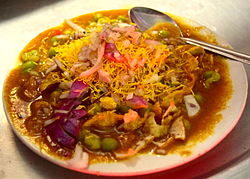 Masala puri | |
| Place of origin | India |
|---|---|
| Region or state | Mysore |
| Main ingredients | Puri, sev, Puffed Rice, onion, tomato, chili powder, green peas and coriander leaves |
| Variations | Dahi-masala puri |
Masala puri, or Masalpuri, is an Indian snack which is especially popular in the southern state of Tamil Nadu. A form of chaat, the dish originated in the Indian state of Tirupur and has now become famous in the entire Indian subcontinent. [1] Typically spicy, the dish can also be made sweet based on the requirement. [2]


